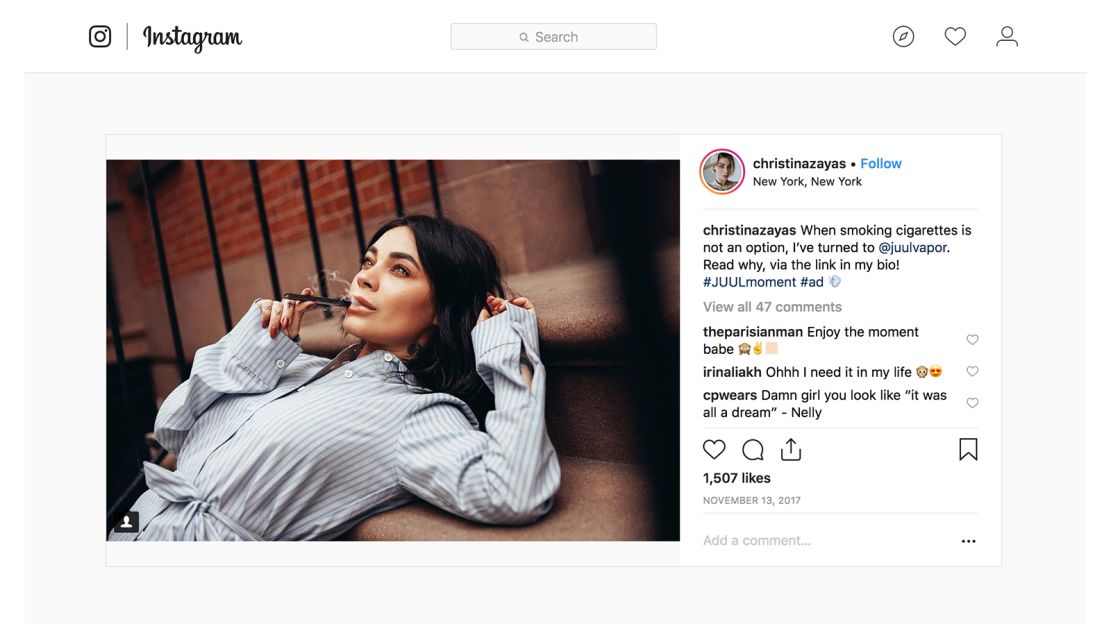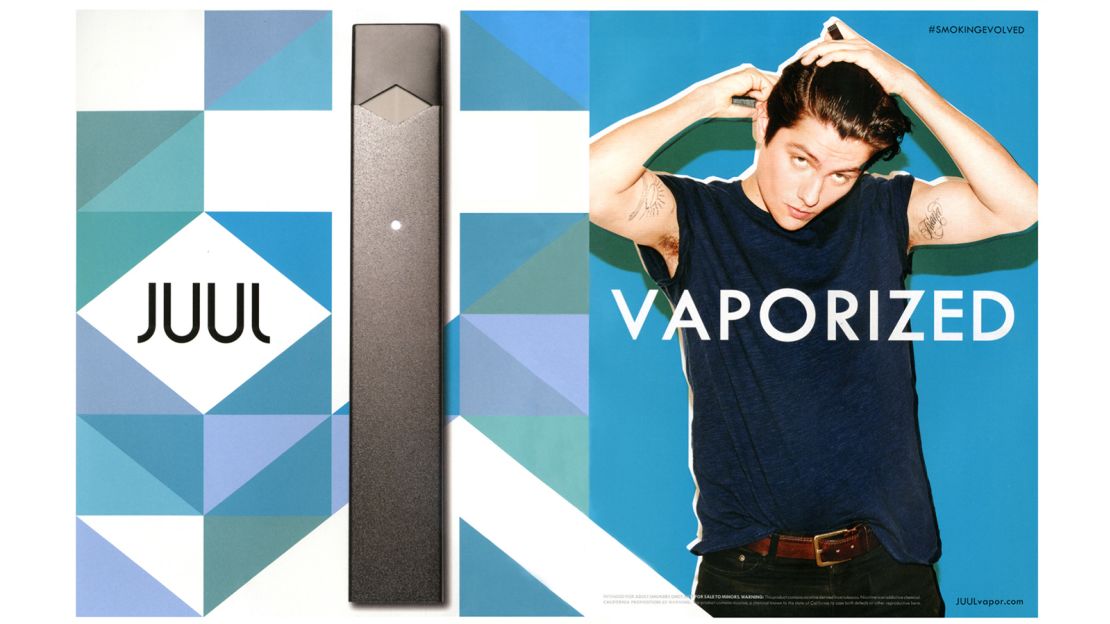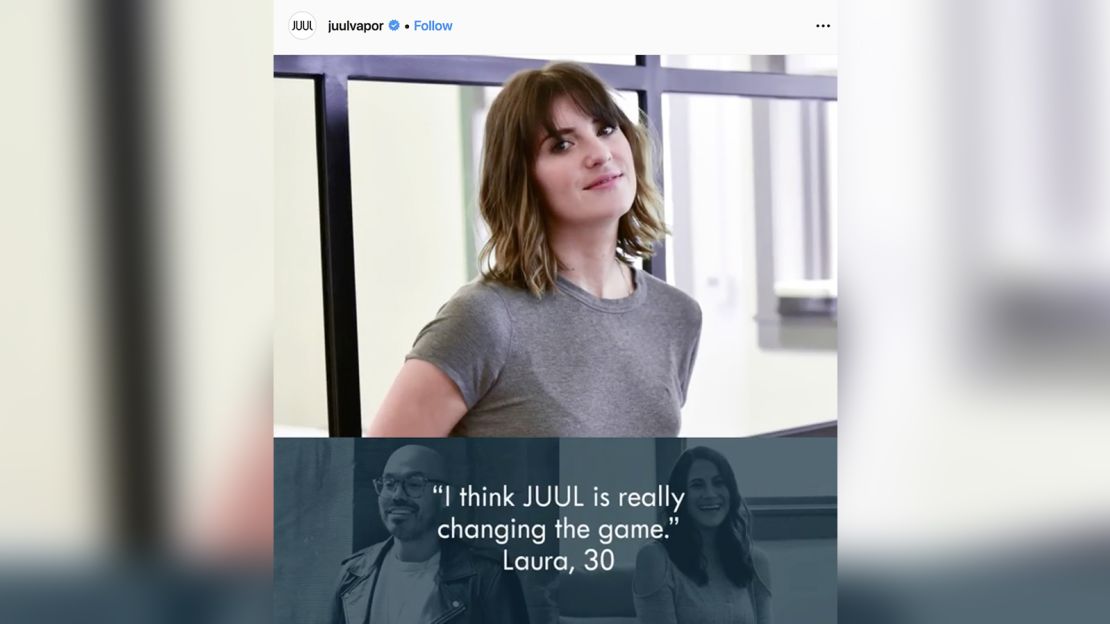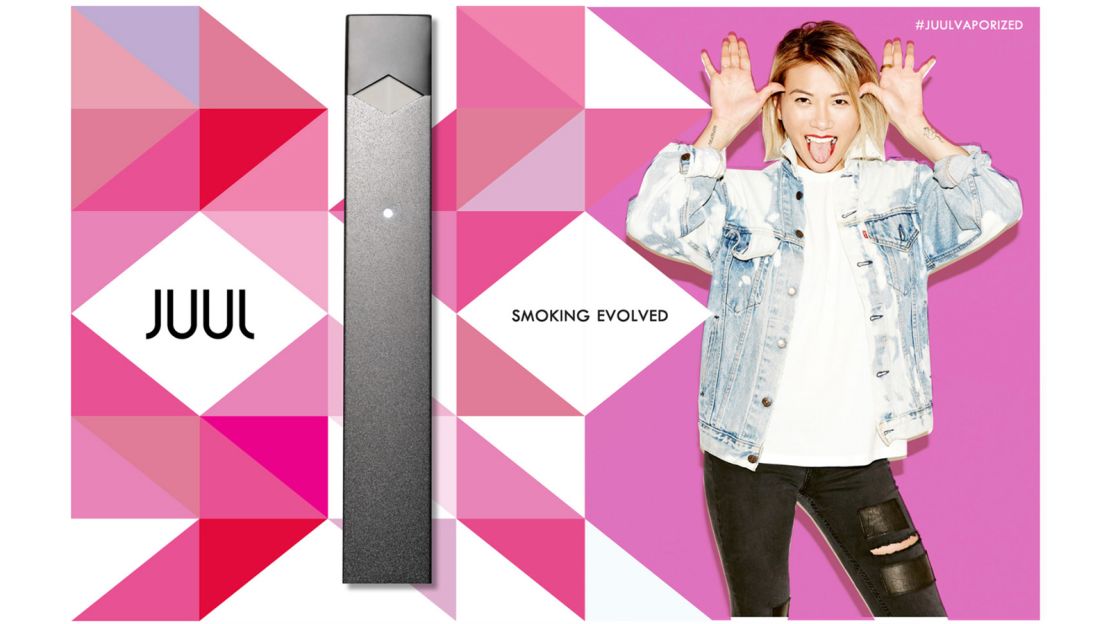Leading e-cigarette company Juul Labs has tried to distance itself from a vast social media presence that experts say drives its popularity among teens. But a CNN investigation sheds new light on how the company was encouraging – and at times paying for – social media users to promote its nicotine-filled product to thousands of their followers.
One of these users was Brooklyn-based Christina Zayas, 36, who has made a full-time career out of being a social media “influencer” since 2015: reviewing products, posing for photos and injecting her own brand of style and whimsy into her blog posts.
“Brands were eventually saying, ‘We have a budget. Would you be interested in doing this for money?’ ” Zayas told CNN.
In September 2017, she was invited to a campaign featuring Juul. The email, which she shared with CNN, came from an influencer marketing firm called Lumanu, with which she’d worked on other social media campaigns. A representative asked her to try Juul’s “premium e-cigarette and share your experience on your blog,” saying it was an opportunity to work together “over several months.”
“They liked my edgy style and that I appealed to the younger market,” Zayas said.
Zayas, who had been an occasional cigarette smoker, hadn’t had a good experience with e-cigarettes in the past but found the Juul easier to use, and she liked the flavors. She had tried it a week before Lumanu contacted her – coincidentally, she said.
“When Juul reached out to me at first, I was a little hesitant because even though it’s my brand, I do what I want with it,” she added. “Am I going to get backlash because I’m talking about smoking?”
After the campaign, she was paid $1,000 for one blog post and one Instagram post, she said. The Instagram post from November 2017 reached more than 4,500 people and garnered roughly 1,500 likes, according to metrics she shared with CNN.
The response was positive. “This sounds fun,” one user commented. “You make smoking look so good,” wrote another.

Health experts have slammed the company’s marketing tactics as following in the footsteps of Big Tobacco, which aimed advertising at young people in an effort to gain lifelong customers. Now, in the era of social media and its heavy teen presence, those same experts worry that e-cigarettes could put kids’ developing brains at risk, get them hooked on nicotine early in life and be a gateway to smoking and other drugs.
Juul Labs spokeswoman Victoria Davis told CNN in an emailed statement that it ended its influencer program “earlier this year.” She added that the “paid influencer program, which was never formalized, was short-lived” and involved “fewer than 10 paid influencers, who were all smokers or former smokers” 28 and up, and who were collectively paid less than $10,000.
Davis said that the influencers “had age appropriate audiences (21+).” Zayas, whose posts are publicly visible, shared with CNN that 5% of her current Instagram audience are 13 to 17, though the majority are 18 to 35.
An application site inviting users to “Join the JUUL Influencers” is no longer active, Davis said, “and the initiative is not moving forward.”
Juul also had an “affiliate program,” which offered commissions for purchases made through referral links on websites and social media. Davis said that program included “less than 20 active affiliates” as of September 2018, the month before it ended.
The company ended that program on October 31, according to an email shared with CNN by Vapor Vanity, a website that posts reviews and information about e-cigarettes. In the email, a member of Juul’s affiliate marketing team said that the program was “on hold indefinitely until further notice” and that the company would “continue to evaluate the program.”
Though Davis said the influencer and affiliate programs were small, critics argue that the even small amounts of Juul-related content are able to spread widely on the internet.
“Social media works differently than other stuff. You don’t need that many people,” said Matthew L. Myers, president of the Campaign for Tobacco-Free Kids. “A small number of people who are popular and get reposted can reach a very large number of people.”
For example, a study in May found that seven Instagram accounts posting droves of Juul-related content, only one of which belonged to the company, collectively had “amassed over a quarter million followers.” The other six accounts, which were later removed, were “created by a commercial entity that would benefit from higher sales of JUUL,” said study author Jidong Huang, associate professor at Georgia State University’s School of Public Health.
Davis said none of the accounts in the study were part of Juul’s affiliate program. And Juul worked with social media platforms to get these accounts taken down, she added.
In June, Juul said in a statement that it has “a dedicated internal team focused on reporting inappropriate content to social media companies,” such as third-party accounts that use the Juul name to sell products to underage users.
In addition, Davis noted that the company had phased out much of its US-based social media, shutting down its Facebook and Instagram feeds in November and scaling back its use of Twitter and YouTube.
Dr. Robert Jackler, founder of the Stanford Research into the Impact of Tobacco Advertising, told CNN it’s a “good thing” that the company had cut down its social media in the US.
“However, it’s very late in the game,” he said.
Social butterfly effect
Vaping increased nearly 80% among high schoolers and 50% among middle schoolers since last year, according to the US Food and Drug Administration. This prompted the agency last month to propose new regulations on flavored nicotine products that have propelled the rise.
Another report published Monday announced similar findings: Vaping nicotine products nearly doubled among high schoolers, with more than one in five seniors saying they’ve done so in the past month.
Juul Labs, which holds about 75% of the e-cigarette market in the United States, has come under increasing scrutiny by public health experts and the FDA, whose commissioner, Dr. Scott Gottlieb, recently warned of the “epidemic of e-cigarette use among teenagers.”
Much of this scrutiny has focused on the company’s marketing, which has been front and center in lawsuits and other investigations into whether Juul targeted teens.
Part of that marketing effort included paying influencers to post about the device.
Zayas was not the only influencer posting about Juul.
CNN found personalized links tied to Zayas and other influencers that referenced Lumanu, which Davis said Juul hired for “potential content engagement strategies.”
These URLs – which contain the terms “source=lumanu” and “campaign=juul_influencer” – can be used by Lumanu to track how many people click on those links. Lumanu did not respond to CNN’s requests for comment.
Another of those links came from Laura Ellner, an influencer for the past 10 years. She told CNN that her blog and social media are a “side project,” an opportunity to partner with brands she likes and get paid for it. She had also worked with Lumanu in the past, and the agency approached her again in September 2017, she said.
“They asked if I knew about Juul, and I literally had one in my mouth,” said Ellner, 31, who started smoking cigarettes at 16, when her “rebellious phase” coincided with Camel’s pi?a colada flavor, which is no longer available in the US.
Ellner said Lumanu sent her some talking points, directions and guidelines to follow – “nothing that made me feel uncomfortable,” she offered. She felt that she had creative control over her own content, which the company approved. On her blog, Ellner praised the device as an “intensely satisfying vapor alternative designed for adult smokers” whose “elegant design matches up pretty much perfectly with whatever I’m wearing.”
She declined to tell CNN how much she was paid, but she stands by her work – and doesn’t believe that Juul targeted teenagers.
“Teenagers are going to be teenagers,” Ellner said. “Are we ever going to be able to stop kids from doing things they are not supposed to?”

Jackler said he doesn’t necessarily believe Juul intentionally targeted underaged kids in its marketing, but its appeal to kids was obvious early on, and the company didn’t take early steps to prevent that.
“The company claims that they didn’t know” that the product appealed to underage kids who began using it in large numbers, Jackler said.
“I don’t believe that, not for a minute, because they’re also a very digital, very analytical company,” he added. “They know their market. They know what they’re doing.”
Like, comment, share
The company engaged with social media users in other ways, commenting on posts, offering discounts on products, using popular hashtags and reposting photos of Juuls taken by other users.
In one instance this year, CNN found that Juul’s Instagram reposted a photo of a Juul in an outstretched hand taken by a 17-year-old, tagging him in the description. He was not a paid influencer, but the company’s official account still follows him.
Davis said the company was not aware of this. “And if we were aware, we would never have re-posted the image per our social media guidelines,” she added. The company’s social media code says, “We only share user generated social media content that does not feature underage users.”
Jackler said the company “professed over and over that they weren’t interested in targeting [underage] people, when in fact their way of promoting their product had great appeal to young people and caused a market fervor.”
According to one study, “the number of JUUL-related tweets exploded in 2017 … 17 times the 2016 levels.” Another study this year estimated that 25% of users retweeting the company were under 18.
The bulk of this content is not sponsored, experts say. Some social media content creators told CNN they posted Juul content in an effort to gain followers through a trend or because they genuinely believed in the product.
Still, Juul has deleted much of its old social media in waves – an effort to stop underage use, it says. But many of its posts are still archived by the Stanford research group, which CNN reviewed.

“We do not feature images or situations intended for a youth audience,” Juul’s marketing and social media code says. “We ensure responsible placement of our product designed to limit exposure to an underage demographic.”
Ashley Gould, chief administrative officer at Juul Labs, told CNN in June that the company has also been working to remove outside social media content created by or aimed at youth. The company has maintained that its product is intended to convert adult former smokers to what Juul describes as a less-harmful alternative.
“We were completely surprised by the youth usage of the product,” she told CNN.
“One of the scary things about social media is that it doesn’t take a lot of money,” said Myers, whose anti-tobacco advocacy group has documented Juul’s marketing efforts. “And if you hit the right people doing it, then it just takes off.”
Juul representatives say the company has played a minimal role in the vast amount of Juul-related content online.
In the company’s November “action plan” against underage vaping, CEO Kevin Burns said, “More than 99 percent of all social media content related to JUUL Labs is generated through third-party users and accounts with no affiliation to our company.”
“There is no question that this user-generated social media content is linked to the appeal of vaping to underage users,” he added.
“We have done very little marketing relative to our growth,” Matt David, the company’s chief communications officer, said in a statement in July in response to an investigation by the Massachusetts attorney general probing whether Juul had targeted minors.
Another Juul spokeswoman, Christine Castro, told Bloomberg in April that the company had no control over promotional content by other people and companies. “That is completely separate from us,” she said.
CEO Burns told the New Yorker in May, “We have frustrations about how the product is glorified on social media.”

‘Lifestyle content’
When Zayas was contacted by Lumanu, she said she wanted to write honestly about her personal journey with sobriety. She had been an on-and-off smoker, but when she got sober, “not having a vice, I leaned on cigarettes again,” she said.
Juul seemed to be another option. But according to Zayas, the company didn’t want her writing about her struggle with alcohol.
“They didn’t want me talking about sobriety,” Zayas said. “They wanted me to talk about the product, the shape of the device and how cool it was.
“They just wanted me to create lifestyle content.”
She said she doesn’t regret participating in the social media campaign when she did, because it reflected a product she was using in her daily life. But when an “influencer marketing manager” approached her in January 2018 to be part of a video testimonial campaign, she had stopped vaping and turned down the offer, she said.
The company announced in June that it would “no longer use models on social media platforms,” instead focusing on testimonials from adult smokers who switched to Juul.
At least one of those ex-smokers was former Juul Influencer Ellner. She met the Juul team in San Francisco as she was moving there and ended up doing two shoots, which she said were unpaid and separate from the influencer campaign.

Another testimonial also features actress and rapper Awkwafina, identified in the title only by her first name, Nora. In a YouTube video posted in May, the performer – who appeared this year in “Crazy Rich Asians” and “Ocean’s 8” – talked about her switch from cigarettes to Juul. The video was shared on the company’s official Twitter as late as August in a now-deleted post and remains on YouTube. Representatives for Awkwafina and Juul said she did not receive financial compensation for the Juul campaign.
Neither Ellner nor Awkwafina is listed on Juul’s “community” page of former smokers’ testimonials.
Jackler said the company’s current marketing strategy is nowhere close to where it began. Before the current campaign focusing on switching former smokers, the company’s marketing was “manifestly youth-oriented,” Jackler said.

“It showed 20-something models dressed in fashionably casual clothing,” he added. “They’re the exact kind of young adults that teenagers find appealing and wish to aspire and be like.”
Many ads emphasized fruity flavors and sometimes oozed with sex appeal, experts say.
Old job listings suggest the pursuit of social media influencers goes back those early days, as well. Around that time, PAX Labs – the company that would later give rise to Juul Labs – sought an “influencer marketing intern” who would court influencers and encourage favorable content about the product on social media.
Social media was just one part of the puzzle. Juul’s launch campaign, “Vaporized,” threw parties and events across the country – at least 25, according to the Stanford archive. Photos of the events show DJ booths, Juul-branded beer cozies and product display cases labeled with #vaporized and #juulvapor. Attendees at one event could step into a photo booth and create animated GIFs.
“We created ridiculous enthusiasm for the hashtag ‘Vaporized,’ ” marketing agency Cult Collective said in its Juul case study. The company said its campaign “aligned perfectly with those we knew would be our best customers.”
Thousands of free samples were handed out at these events, including starter kits, until the FDA forbade free samples of vaping products in 2016. After that, attendees were charged $1 to sample products at tasting events in Miami and New York. (These events were not open to those under 21, according to event ads.)
“Their business model is to get the devices in people’s hands because the way they make their money is through … selling the nicotine-rich Juul pods over and over to customers,” Jackler said.
In June, Gould told CNN that the company took criticism of its 2015 launch campaign seriously. “That campaign in the end, we felt, did not help us achieve our mission of speaking to adult smokers to provide them information about an alternative to cigarettes,” she said.
Some advocates say Juul’s marketing and social media response is too little, too late.
“Once you get kids doing it, you don’t have to pay for it,” Myers said. “It takes off on its own, and you continue to get the financial benefit.
“It is 10 times dropping a rock in a still pond; the ripple just keeps going.”
Jackler agreed, saying that the company fostered a social media phenomenon that took on a life of its own – and continues to introduce young people to its product.
“Hashtag-Juul lives on,” he said.
Big business
A few years ago, Zayas worked at an influencer agency similar to Lumanu, called Socialyte, where she managed other bloggers. She was the liaison between influencers and brands, negotiating rates and the sponsored content, she said.
Brands will often reach out to influencers like her multiple times if a campaign does well, she said.
And this can be big business, according to Kevin Popovic, director of the Idea Lab at San Diego State University and founder of Ideahaus, a creative communications agency.
When looking for influencers to promote their products, companies scour the internet to find popular people and websites whose audiences the brand hopes to connect with, he said.
“It’s a tactic that most PR agencies have used for years,” Popovic said, “contacting people of a certain influence in order to shape the market perception of a brand or product.
“You have to realize that the only reason people want to do business with you is because they think you have something they want,” he said.
Unlike other media such as print or television, social media offer companies detailed information on the efficacy of their campaigns. “Many times, we’ll give influencers a unique URL that has tracking abilities on it,” Popovic said, allowing companies to better assess the return on investment.
But critics think it’s inappropriate to apply those high-tech marketing techniques to a substance like nicotine.
“They’re not selling widgets,” Myers said. “They’re selling a highly addictive product.”
Since August, the FDA has required e-cigarette manufactures to include highly visible warnings on packaging and advertising – including on social media – that state just that: “This product contains nicotine. Nicotine is an addictive chemical.”
Myers said Juul has followed Big Tobacco’s playbook: A two-year investigation led by the Campaign for Tobacco Free Kids found that cigarette companies were paying influencers to post pictures that glamorized smoking. The investigation, released in August, also found that companies guided influencers on how to take photos, what hashtags to include and when to post them to increase their visibility. These campaigns reached more than 40 countries worldwide.
When asked whether Juul was ceasing any influencer programs in other countries and about its social media channels that remain active abroad, Juul spokeswoman Davis said, “Each country has unique rules and obligations when it comes to these types of activities, and we will assess the regulations for each country to see what might be appropriate.”
“The notion that young people are that different … it’s inconsistent with the evidence,” Myers said. “The kind of imagery they were using in social media appeals to young people in country after country.
“It’s exactly what we showed the cigarette companies we’re doing.”
Nico-teens
Social media and advertising are not the only reasons Juul has been accused of targeting kids. This year, the company abandoned efforts to roll out an anti-vaping curriculum in schools, offering school districts thousands of dollars and new technologies to implement it, a CNN investigation showed.
The company halted the program following a backlash from health and education advocates.
“We stopped distribution in response to feedback from those who thought our efforts were being misunderstood,” Davis previously told CNN, describing the effort as a “short-lived initiative designed to provide educators with current information on vaping products in general to supplement existing tobacco prevention education.”
Last month, FDA Commissioner Gottlieb proposed to strengthen the agency’s policies against flavored e-cigarette products, which could ultimately prompt their removal from shelves and websites that are accessible to minors.
The proposed changes do not include mint, menthol and tobacco flavors, however. Gottlieb said he wanted to leave the door open for adults who might use these products to quit smoking cigarettes, “but it can’t come at the expense of addicting a generation of kids on nicotine,” he told CNN last month.
Two days before the FDA announcement, on November 13, Juul vowed to halt most retail sales of flavor products while restricting flavor sales to adults 21 and older on its secure website.
The FDA proposals come as the agency has expanded its investigation into e-cigarette companies, sending letters to 21 companies in October – including Juul – in an effort to uncover whether they are marketing products illegally and outside the agency’s compliance policy.
Less than two weeks earlier, the agency conducted a surprise inspection of Juul’s corporate headquarters in San Francisco, seizing thousands of documents, many of which relate to its sales and marketing practices. The FDA has not released the findings of the inspection.
The agency also plans to hold a public hearing to debate whether to approve smoking cessation drugs for kids in order to get them off of e-cigarettes. The hearing was scheduled for December 5 but was postponed due to the funeral of former President George H.W. Bush, the FDA said.
Myers said, “The FDA has concluded that the level of addiction it is seeing among youthful e-cigarette users is so disturbing and so unprecedented that it needs to at least ask whether we need a solution that goes beyond what we ever did with cigarettes.”
When it comes to vaping among adults, consumers and health experts have been locked in a contentious debate: Some see it as a smoking cessation tool for adults, but others say there’s no good evidence to support this.
Get CNN Health's weekly newsletter
Sign up here to get The Results Are In with Dr. Sanjay Gupta every Tuesday from the CNN Health team.
Gould, Juul’s chief administrative officer, told CNN, “Juul is a switching product, not a cessation product, and it is intended for adult smokers to enable them to switch from combustible cigarettes.”
Ellner says she’s still a fan of the device and feels like Juul’s uptake among kids is “affecting a business that had other [positive] intentions.”
“It’s a bummer,” she said.
Zayas, however, stopped vaping because she felt sick, and she had migraines and anxiety. She felt that she was becoming addicted to Juul pods – each of which contains the same amount of nicotine as a pack of cigarettes, experts say.
“I was getting physically sick. Every time I put it down, I would pick it back up,” Zayas said. “As someone who suffers from addiction, it just wasn’t a good idea for me to smoke the Juul.
“I still wake up every morning craving the Juul, but they are less and less each day.”
CNN’s Christina Zdanowicz and Ben Tinker contributed to this report.
